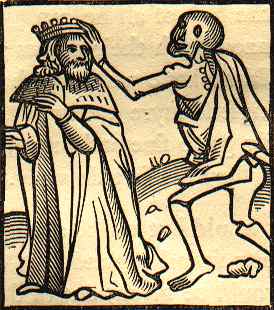Death and mortality
The many plagues which decimated England and Europe helped shape a culture in which death was an ever-present yet mysterious force in daily life. Images of corpses and skeletons abound in the art of the 14th and 15th centuries, often in connection with the medieval Death Dance*.
The prevalence of death imagery in medieval artwork may seem obsessive, but this cultural phenomenon was a vital part of medieval society's attempt to comprehend a very real danger. In an era with high mortality rates, mass deaths due to disease, and little knowledge of medicine and hygiene, death was an inescapable mystery. Whole villages and urban districts could be wiped out for no comprehensible reason. It is not surprising that the decimation caused by the plague was considered to be a sign of God's displeasure.
An interesting side-effect of the plague was the belief that death was the great leveler: your time would come whether you were a prince or a pauper -- a fact that Hamlet was particularly aware of*.
Death in Shakespeare's London
Public executions, mutilations, and corpses on display were common sights to the residents and playgoers of Shakespeare's London. London bridge, on the way from the city to the Globe theater, was a common place for the exhibition of traitors' heads. The Globe theater itself was located next to a bear-baiting ring, and many other theaters did double duty as places to see both drama and blood-sports.
Death and the Shakespearean theater*.
Footnotes
-
Dancing in the grave
In medieval art and iconography, the Dance of Death is depicted as a carnival in which skeletons and corpses revel along with the living. Grinning skeletons lead people off to the afterlife, often with an air of joviality and humor.
The Dance of Death was a popular festival with origins in the plague-ridden medieval period. Like most rowdy gatherings, the Death Dance was mainly an opportunity for common people to dispense with the usual social constraints and enjoy some licentiousness. Not surprisingly, this unusual festival inspired imagery and themes which were central to the popular mythology surrounding death.
In a related artistic tradition, armies of conquering skeletons sweep through villages riding carts piled high with the dead. Such apocalyptic images represented what many thought was the end of the world.
-
"Alas, poor Yorick . . ."
The imagery and themes of the Dance of Death are central to the graveyard scene in Hamlet. As Hamlet talks with the gravedigger, various skulls are unearthed and casually tossed aside. Hamlet comments that regardless of status, breeding, and worth in life, death reduces everyone to so many old bones, knocked about by a lowly gravedigger's shovel:
Did these bones cost no more the breeding but to play at loggets with them? Mine ache to think on't
(5.1.91)The questions Hamlet asks become even more personal when he finds the skull of an old friend -- the jester, Yorick.
The influence of the Death Dance in this scene lies not only in Hamlet's musings on death as the ultimate equalizer but also in the simple and powerful image of a living human holding another human's skull (or lying on the ground face-to-face with it, as Mel Gibson does in Zeferelli's film version). Given the fact that Yorick's prior occupation was court Fool, the image of capering skeletons has special relevance to this scene. Like the hand-in-hand dances of the quick and the dead, Hamlet and Yorick represent the inevitable, egalitarian, and capricious nature of death.
In a similarly democratic fashion earlier in the play, Hamlet specifically remarks:
We fat all creatures else to fat us and we fat ourselves for maggots. Your fat king and your lean beggar is but variable service -- two dishes but to one table.
(4.2.21-4) -
From scaffold to stage
Most forms of publicly-endorsed violence shared an important trait: they were spectacles staged to capture the attention of an audience. People from all walks of life would make an outing to see an execution just as people today might to a sporting event. Bear-baiting, bull-baiting, and cockfighting went hand-in-hand with drama as popular entertainments, and often shared the same building.
This connection between violence and entertainment had a strong influence on the Elizabethan and Jacobean drama. Death and other forms of violence on stage were commonplace. The brutality in early plays such as Shakespeare's Titus Andronicus, Kyd's Spanish Tragedy, and Marlowe's Jew of Malta is still to be found in later plays like King Lear, Macbeth, and the extrordinary ingenuity of such revenge plays as The Revenger's Tragedy. Then, as now, death and violence were exploited for their theatrical potential.
